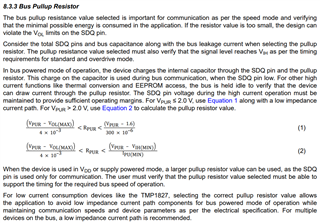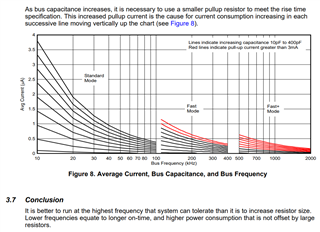Tool/software:
Hello! I just want to confirm if the VDD <4.2uA applies when powered by one wire versus powered by VDD
thanks!
This thread has been locked.
If you have a related question, please click the "Ask a related question" button in the top right corner. The newly created question will be automatically linked to this question.
Tool/software:
Hello! I just want to confirm if the VDD <4.2uA applies when powered by one wire versus powered by VDD
thanks!
Cameron,
Device current consumption will not increase under bus power. 4.2uA is not the max current consumption, because it will consume 94uA typ during a temperature conversion that lasts 3 or 5.5ms.
thanks,
ren
Thanks ren! What’s the max possible current we could draw over 1-wire?
asking because I wanna make sure our MCUGPIO can provide enough current
In bus powered mode, device power comes from the pull-up resistor. Do you intend to power the resistor with a GPIO? This is not necessary for implementation.
Regardless, the max current through the resistor will occur when the bus is pulled down for a logic low. The resistor must be sized to not violate the 4mA VOL spec. Therefore, the max current is 4mA.
ren
I was thinking: no pull-up resistor, and directly tying 1-Wire pin to a push-pull GPIO on the host. Most MCU GPIOs can source 1-2mA which should be enoughI believe. I like this approach because then we can kill power to the TMP1827 for lower power consumption when not in use
You would have to program the GPIO pin such that it goes to a high impedance state (with pull-up) during the periods where TMP1827 responds.
ren
Ahhhhh my wires were crossed. My understanding: the TMP1827 is an open drain 1-wire which requires a pull-up. When it drives low, it opens the drain and sinks up to 4mA.
so if I wanted a lower power solution overall, I should size my pull-up resistor larger. For example, 1.8V pulled up with a 480 ohm resistor would burn more system current than a 4k Ohm resistor.
my next question goes to: what is the highest pull-up resistance I could use to maximize system battery life? Thanks!
Please see section 8.3.3 of the datasheet which describes different pull-up formulas based on the voltage used.

However, I don't recommend using the maximum resistor value. In Low-Power Design Techniques for Temperature-Sensing Applications, I conclude that the lowest power is achieved by running the highest speed that your bus capacitance will support. This is because lower speeds draw the high current for longer, and this outweighs the benefit of reducing the current. While this analysis was done on I2C, it applies to 1-Wire as well, since they are both open-drain with similar frequencies and currents.

thanks,
ren
Thanks ren that’s good to know! Probably my final question- Does the IC put itself into a low power state while it waits to be communicated with? If so, what is the max power draw in that state?
im assuming the open drain FET is closed when not communicating

Standby current is only used in Continuous conversion mode. The lowest power will be achieved in Shutdown mode, with One-Shot commands sent to trigger measurements (conversions) as needed. This is described in 8.4.1 Device Functional Modes.
thanks,
ren